Our History
Good Samaritan Hospital - The Quiet Giant of Surgical Innovation
At the termination of the Revolutionary War in the late 1700's the United States government obtained Cincinnati as part of the Northwest Territory. With the city's advantageous position on the Ohio River and subsequent development and introduction of steamboats in the early 1800's, Cincinnati turned into a major center for commerce and trade. With a population of over one-hundred fifteen thousand in 1850, Cincinnati was the sixth largest city in the United States, ahead of both St. Louis and Chicago, making it the first major city west of the Allegheny Mountains and largest inland city in the nation.
St. John's Hospital (1852)

Good Samaritan Hospital, originally a mere 20 beds and named St. John's Hospital, was established in 1852 as the first private and second hospital in the city, with Reuben D. Mussey holding the position of chief of surgery. Mussey, also professor and chair of surgery at the Miami Medical College, was known as an obsessive scientist, published numerous case reports in various medical journals, was a founder and the first president of the Academy of Medicine of Cincinnati, and played an instrumental role in the development of the American Medical Association, which he went on to serve a term as president.
Within three years the demand placed on St. John's Hospital was overwhelming, which prompted relocating with accommodations for up to 75 patients. With George C. Blackman practicing within its confines and holding the position of professor and chair of surgery at the Medical College of Ohio, St. John's quickly became known as an outstanding institution. Blackman made frequent and voluminous contributions to the medical literature, translated surgical texts, and was one of the most widely respected surgical authorities in the United States being quoted by the likes of Samuel D. Gross. His significant contributions to the field of surgery brought both himself and St. John's Hospital international acclaim.
The Hospital of the Good Samaritan (1866)
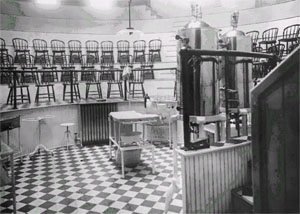
With Blackman succeeding Mussey as the chief of surgery, increased demand placed on St. John’s Hospital prompted yet another move to a larger 95 bed facility in 1866, coinciding with a renaming of the hospital to The Hospital of the Good Samaritan. Roberts Bartholow played an instrumental role in soliciting contributions for the construction of an over four-hundred seat surgical amphitheater, and conducted the first known experiment on the brain in 1874, leading to an article published in the Saturday Evening Post in 1949 referring to Bartholow as the “forerunner of all who operate on the human brain.” Authoring numerous texts and making frequent contributions to the literature, Bartholow’s prominence and international recognition allowed him to be presented fellowships in numerous prestigious societies.
William W. Dawson, succeeding Blackman, assumed the role of chief of surgery at Good Samaritan and professor and chair of surgery at the Medical College of Ohio. Known for being a brief, pointed, and practical surgeon, Dawson made multiple contributions to the literature by way of case reports, was known for his research into deaths from chloroform use, and had a great passion for the advancement and profession of surgery holding the position of president of the Cincinnati Academy of Medicine, Ohio State Medical Society, and American Medical Association.
Phineas S. Connor, ultimately succeeding Dawson as chief of surgery at Good Samaritan and professor and chair of surgery at the Medical College of Ohio, carried out his most well known and distinguished work in the hospital amphitheater. Credited for performing the first reported tarsectomy in 1883 and gastrectomy in 1885, he also made numerous contributions to the periodical literature, and was an associate editor of Keen and White’s American Text Book of Surgery. Connor served terms as president of the American Surgical Association, American Academy of Medicine, Ohio State Medical Society, and the Cincinnati Academy of Medicine.
Good Samaritan Hospital (1915)
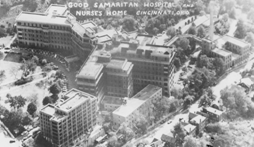
With the infrastructure of The Hospital of the Good Samaritan becoming wholly inadequate for its continually growing needs land at the corner of Clifton and Dixmyth Avenues was purchased for future expansion in 1907. Work began on the new building in 1910 after an over 200,000 dollar campaign was undertaken to help fund the construction. September 1, 1915 marked a historical event in Cincinnati when The Hospital of the Good Samaritan moved to a newly constructed and magnificent state of the art facility adopting the name for which it is known today; Good Samaritan Hospital. With the initial construction and dedication of the west wing, and completion of the north wing three years later, the hospital provided 400 beds, four major and five minor operating rooms and the most advanced equipment and technology in the city. Not long after, in 1937, the further addition of an east wing increased the capacity of Good Samaritan Hospital to 639 beds.
Frank H. Mayfield Founds Department of Neurosurgery (1937)
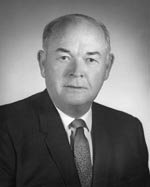
Frank H. Mayfield arrived in Cincinnati and founded the department of neurosurgery at Good Samaritan Hospital in 1937, formed a graduate training program for neurosurgery in 1946, and developed an outstanding community based neurosurgery residency program in 1969. From the time of his arrival, Mayfield contributed significantly to advancements in the field of neurosurgery including the development of the Mayfield clip and headrest system.
Throughout his career he held numerous positions of leadership, made enormous contributions to the surgical literature as well as authored and co-authored major neurosurgical texts, and received a plethora of honors including being selected as the first recipient of the Harvey Cushing Medal of the American Association of Neurological Surgeons in 1977. Mayfield initiated a group practice that has become one of the largest neurosurgical practices in the world, regarded as a center of excellence in neurological surgery which is still in existence today; known as the Mayfield Clinic and Spine Institute.
First Vascular Surgery Laboratory in United States (1959)
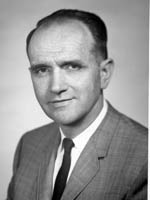
In 1959 Good Samaritan Hospital offered a budding vascular surgeon by the name of John J. Cranley space and facilities for the development of a laboratory, which he developed into the first completely dedicated surgically oriented vascular laboratory in the nation. Major developments and innovations were carried out in Cranley’s laboratory including the invention and development of the Fogarty balloon embolectomy catheter, the Fogarty clamp, the Cranley-Grass Phleborheograph, and new applications for B-mode ultrasonographic imaging of veins and arteries. With continual advancements being made, Cranley’s laboratory became one of the largest and busiest in the world. Cranley made numerous contributions to the surgical literature as well as authored a number of vascular surgery texts. Although the general surgery residency program had been in existence since 1928, and accredited in 1954, it was only in 1961 when Cranley was appointed director of the residency program that he also became the first paid director of the department of surgery. In 1973 a dedicated vascular surgery residency was also established, with Cranley holding the role of director. Cranley’s name is still ever present with the continued existence of the John J. Cranley Vascular Laboratory, the annual John J. Cranley Memorial Lectureship, and the surgical group Cranley founded; The Cranley Surgical Associates.
Fogarty Balloon Catheter Developed

Known for being an outstanding mentor, Cranley had a profound influence on those around him. Fogarty, a high school student at the time, met John Cranley while working at Good Samaritan Hospital as an orderly, eventually becoming Cranley’s scrub technician in the operating room, where together they discussed the inadequacies of the surgical techniques and instrumentation used to remove blood clots from arteries. Fogarty worked with Cranley to find an alternative solution for the removal of blood clots, and while in medical school at the University of Cincinnati he designed and developed a balloon catheter for the removal of blood clots in extremity arteries. Under the mentorship of Cranley, Fogarty performed experiments on animals and cadavers, eventually perfecting his idea and inventing a device that would have a profound effect on the field of vascular surgery. The balloon embolectomy catheter, which Fogarty developed in the early 1960’s as a 4th year medical student, was the mere start to his internationally recognized career as an entrepreneur, inventor, teacher and outstanding cardiovascular surgeon.
Ultrasonic Lithotripsy Pioneer
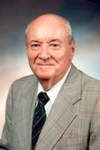
Completing an internship at Good Samaritan Hospital, followed by residency training at the University of Minnesota under Dr. Frederic E.B. Foley, inventor of the Foley urological catheter, Dr. William P. Mulvaney returned to Good Samaritan in 1952. Mulvaney started experimenting with ultrasonic vibration in 1953 in an attempt to fragment kidney stones, eventually developing the first ultrasonic lithotripsy to break up urinary calculi. His pioneering research was recognized by the American Urological Society as a milestone in urology that drastically reduced the need for open surgery. He went on to develop Renacidin in 1959, which dissolved struvite stones, thus eliminating the need for surgical removal. In 1965, with the use of carbon dioxide and lasers, he attempted to vaporize a bladder calculus, which led to his pioneering work on using lasers to treat bladder tumors and prostate disease. Among his many achievements, while practicing at Good Samaritan Hospital, was performing the first adult human cadaveric kidney transplant in the city of Cincinnati in 1964, as well as opening the first hemodialysis unit in the city.
Cardiothoracic Program Started (1976)

Following cardiothoracic surgeon James A. Helmsworth, who performed the first open heart surgery in a private institution in Cincinnati in 1966 and played an instrumental role in the development of the first bubble oxygenator for total bypass of the heart and lungs, Ranjit K. Rath, was instrumental in helping to develop and start the first full time cardiothoracic surgery program at Good Samaritan Hospital in 1976. Prior to that time patients would have to travel great distances to obtain complex cardiothoracic surgical services. Rath has been the recipient of numerous awards, published and presented a host of literature, and holds memberships in a plethora of professional organizations. Being the first in Cincinnati to insert an implantable cardiac defibrillator and place a patient on the Abiomed biventricular support system, among numerous other accomplishments, Rath has helped to build the department of cardiothoracic surgery at Good Samaritan Hospital into one of the strongest in the country.
Surgical Robotics
J. Michael Smith, followed in the footsteps of his mentor Ranjit Rath, and was intimately involved in research, resident training and education, and pushing the envelope with da Vinci robotic assisted cardiothoracic surgery. Smith performed the first robotic assisted cardiothoracic surgery in the city of Cincinnati in 2003, and has trained a multitude of surgeons from nationally and internationally renowned institutions. He held positions of Director for robotic assisted surgery, research for the general surgery residency program, and surgical research for The E. Kenneth Hatton, MD Institute for Research and Education.
A New Era
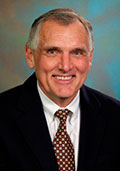
An extensive modernization and expansion project, requiring destruction of old infrastructures and construction of new facilities, was set into motion in 1985, making way for the largest hospital project ever carried out in the history of the city of Cincinnati. Coinciding with the construction, and subsequent retirement of John J. Cranley, Richard E. Welling was named Chairman of the Department of Surgery, as well as Director of both the General and Vascular Surgery Residency Programs. Welling completed his general surgery residency at Boston City Hospital, fellowship training in hepatobiliary surgery at the Lahey Clinic in Boston, and vascular surgery residency in the John J. Cranley Vascular Laboratory. Prior to being named Chairman and Program Director for both residencies, Welling served as Assistant Director of the Department of Surgery at Good Samaritan Hospital from 1979 to 1985. With a plethora of publications and presentations to his name, Welling has been the recipient of numerous honors and awards, holds memberships in the most prominent professional societies, and holds or has held significant positions in a multitude of national committees. Surgical education has been a key focus for Welling, recently being awarded the Parker J. Palmer Courage to Teach Award, and he has played an instrumental role in the progression and development of the Department of Surgery at Good Samaritan Hospital, making both the General and Vascular Surgery Residency Programs two of the strongest and most sought after community programs in the country. In 2007 Welling stepped down as Program Director of the Vascular Surgery Residency being succeeded by Patrick E. Muck, and in 2009 he passed the reins of Program Director of the General Surgery Residency Program to Kevin J. Grannan. After a long and illustrious career Richard E. Welling retired as Chairman on October 1st 2010, twenty-five years to the day of his appointment (October 1st 1985 ' October 1st 2010). Following Welling's departure George M. Kerlakian was appointed Chairman of the Department of Surgery at Good Samaritan Hospital.
Good Samaritan Hospital: An Outstanding Institution!

Since the construction of the then new hospital in 1915, the medical campus of Good Samaritan Hospital has been undergoing constant renovations, growth, and development, propelling it into the oldest, largest, and busiest private teaching and specialty care hospital in the greater Cincinnati area. Currently over one million square feet and housing nearly 600 patient beds including 23 major and 4 minor operating rooms, the medical complex of Good Samaritan Hospital, encompassing more than a city block, has grown substantially since starting as a mere 20 bed facility. With an enormously rich heritage, remarkable clinical reputation, focus on the underserved, and excellence in treatment services as well as medical education and research,Good Samaritan Hospital has grown into one of Cincinnati’s most respected and beloved institutions.